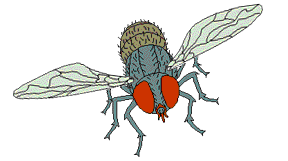
|
Diptera are a diverse order with an enormous range of ecological roles. Every
type of trophic level pattern can be seen in the Diptera.
Dipteran predators
include the robber flies. A variety of herbivores can be
found in the Diptera, such as the economically important fruit flies. Flies are often
parasites, including internal parasites such as the bot fly and external
parasites such as the mosquito,
black fly, sand fly or louse fly. Myiasis is the special term for diseases cause by flies
(such as the screw worm fly) infecting living
tissue. Many flies eat dead organic matter (detritovores), plant or animal
remains. This is especially common in the larval stage, seen in the
filter-feeding mosquitoes and black flies,
the dung-feeding blow flies (Calliphoridae), or the organic deposit feeding rat-tailed maggot.
A number of taxa feed on blood, including horse flies and mosquitoes.
Some flies can be important pollinators for many species of plant (many such
fly-specialized plants, such as Stapelia, Rafflesia, and Aristolochia, produce carrion odors), and many flies feed on pollen and nectar of common plants, and can perform incidental
pollination. Similar relationships occur between flies and various fungi, with flies
dispersing the fungal spores.
The basic fly life cycle is egg, larvae (maggots — see below), pupa and adult
(winged stage), called holometabolism. There is often a difference in
food sources for larvae versus adult dipterans of the same species. For example,
mosquito larvae live in standing
water and feed on detritus while the adults feed on nectar as their energy
source while females utilize blood as their energy source for egg production.
Various maggots cause damage in agricultural crop production, including root maggots
in rapeseed, midge maggots in wheat, and numerous species of leaf miners (note that since fly
maggots have no legs, they almost exclusively feed internally on plants).
Flies rely heavily on sight for survival. The compound eyes of flies are composed of thousands
of individual lenses and are very sensitive to movement. Some flies have very
accurate 3D vision. A few, like Ormia ochracea, have very advanced hearing
organs.
|
 Copyright(C) 2007
- 2020. All rights reserved. Copyright(C) 2007
- 2020. All rights reserved.
|
![]() Copyright(C) 2007
- 2020. All rights reserved.
Copyright(C) 2007
- 2020. All rights reserved.